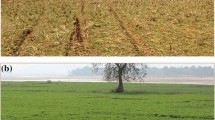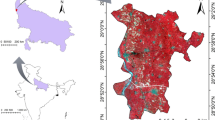Abstract
Pre harvest prediction of sugarcane and sugar production is essential for obtaining the objectives of the national food security mission. Traditional field experimentation results are not reliable and are biased. Improvement in the accuracy and timeliness of crop yield estimation by blending of ancillary data and remotely sensed data in the temporal domain is indispensable. Ratoon sugarcane and planted sugarcane are the two prevalent agricultural practices in India. Ratoon sugarcane crop is suitable both from economic and production consideration. Identification of ratoon sugarcane and monitoring of its growth has been poorly studied. The objective of this study is to extract the information related to the ratoon sugarcane using remote sensing data. The present study proposed NDVIT, an index based on temporal values of NDVI data of Landsat 8 for monitoring and discrimination of ratoon sugarcane. This index has been found to provide 91% accuracy when tested on the ground in the Himalayan foothills region of Uttarakhand. Study indicated that the best period for discrimination of ratoon sugarcane crop is during the first week of April and last week of August to the end of September. This matches with the start of tillering stage and during the period of grand growth stage of the sugarcane.






Similar content being viewed by others
References
Mutanga, S., Ramoelo, A., & Gonah, T. (2013). Trend analysis of small scale commercial sugarcane production in post resettlement areas of Mkwasine Zimbabwe, using hyper-temporal satellite imagery. Advances in Remote Sensing, 2, 29–34.
Rudorff, B. F. T., Aguiar, D. A., Silva, W. F., Sugawara, L. M., Adami, M., & Moreira, M. A. (2010). Studies on the rapid expansion of sugarcane for ethanol production in Sao Paulo State (Brazil) using Landsat data. Remote Sensing, 2(4), 1057–1076.
Simões, M. S., Rocha, J. V., & Lamparelli, R. A. C. (2005). Spectral variables, growth analysis and yield of sugarcane. Scientia Agricola, 62(3), 199–207.
Dempewolf, J., Adusei, B., Becker-Reshef, I., Hansen, M., Potapov, P., Khan, A., et al. (2014). Wheat yield forecasting for Punjab province from vegetation index time series and historic crop statistics. Remote Sensing, 6(10), 9653–9675.
Pupin Mello, M., Atzberger, C., & Formaggio, A. (2014). Near real time yield estimation for sugarcane in Brazil combining remote sensing and official statistical data. In 2014 IEEE International, Geoscience and Remote Sensing Symposium (IGARSS) (pp. 5064–5067).
Dev, C. M., Meena, R. N., Kumar, A., & Mahajan, G. (2011). Earthing up and nitrogen levels in sugarcane ratoon under subtropical Indian condition. Indian Journal of Sugarcane Technology, 26(1), 1–5.
Mulianga, B., Bgu, A., Simoes, M., & Todoroff, P. (2013). Forecasting regional sugarcane yield based on time integral and spatial aggregation of MODIS NDVI. Remote Sensing, 5(5), 2184–2199.
Masialeti, I., Egbert, S., & Wardlow, B. D. (2010). A comparative analysis of phenological curves for major crops in Kansas. GIScience & Remote Sensing, 47(2), 241–259.
Panigrahy, R. K., Ray, S. S., & Panigrahy, S. (2009). Study on the utility of IRS-P6 AWiFS SWIR band for crop discrimination and classification. Journal of the Indian Society of Remote Sensing, 37(2), 325–333.
Dadhwal, V., Singh, R., Dutta, S., & Parihar, J. (2002). Remote sensing based crop inventory: A review of indian experience. Tropical Ecology, 43(1), 107–122.
Chen, S. C., & Spiguel, M. C. R. V. (1984). Evaluation of the possibility of using landsat mss data for sugarcane yield estimation. In N. d. J. Parada (Ed.), Anais... Brazilian Symposium on Remote Sensing, 3. (SBSR), National Institute of Space Research (INPE), São José dos Campos.
Rao, P., Rao, V., & Venkataratnam, L. (2002). Remote sensing: A technology for assessment of sugarcane crop acreage and yield. Sugar Tech, 4(3–4), 97–101.
Morel, J., Todoroff, P., Bgu, A., Bury, A., Martin, J. F., & Petit, M. (2014). Toward a satellite-based system of sugarcane yield estimation and forecasting in smallholder farming conditions: A case study on Reunion Island. Remote Sensing, 6(7), 6620–6635.
Dangwal, N., Patel, N., Kumari, M., & Saha, S. (2016). Monitoring of water stress in wheat using multispectral indices derived from Landsat-TM. Geocarto International, 31(6), 682–693.
Silleos, N. G., Alexandridis, T. K., Gitas, I. Z., & Perakis, K. (2006). Vegetation Indices: Advances made in biomass estimation and vegetation monitoring in the last 30 years. Geocarto International, 21(4), 21–28.
Thenkabail, P. S., Smith, R. B., & Pauw, E. D. (2002). Evaluation of narrowband and broadband vegetation indices for determining optimal hyperspectral wavebands for agricultural crop characterization. Photogrammetric Engineering & Remote Sensing, 68(6), 607–621.
Fortes, C., & Demattae, J. A. M. (2006). Discrimination of sugarcane varieties using Landsat 7 ETM+ spectral data. International Journal of Remote Sensing, 27(7), 1395–1412.
Begue, A., Lebourgeois, V., Bappel, E., Todoroff, P., Pellegrino, A., Baillarin, F., et al. (2010). Spatio-temporal variability of sugarcane fields and recommendations for yield forecast using NDVI. International Journal of Remote Sensing, 31(20), 5391–5407.
Chander, G., Markham, B. L., & Helder, D. L. (2009). Summary of current radiometric calibration coefficients for landsat MSS, TM, ETM+, and EO-1 ALI sensors. Remote Sensing of Environment, 113(5), 893–903.
Wang, J., Rich, P. M., & Price, K. P. (2003). Temporal responses of NDVI to precipitation and temperature in the central Great Plains, USA. International Journal of Remote Sensing, 24(11), 2345–2364.
Turner, D. P., Cohen, W. B., Kennedy, R. E., Fassnacht, K. S., & Briggs, J. M. (1999). Relationships between Leaf Area Index and landsat TM spectral vegetation indices across three temperate zone sites. Remote Sensing of Environment, 70(1), 52–68.
Townshend, J. R. G., Goff, T. E., & Tucker, C. J. (1985). Multitemporal dimensionality of images of normalized difference vegetation index at continental scales. IEEE Transactions on Geoscience and Remote Sensing, GE–23(6), 888–895.
Xue, J., & Su, B. (2017). Significant remote sensing vegetation indices: A review of developments and applications. Journal of Sensors, 2017(1353691), 17.
Hatfield, J. L., & Prueger, J. H. (2010). Value of using different vegetative indices to quantify agricultural crop characteristics at different growth stages under varying management practices. Remote Sensing, 2(2), 562–578.
Huete, A. R. (1988). A soil-adjusted vegetation Index SAVI. Remote Sensing of Environment, 25, 295–309.
Rouse, J. W., Haas, H. R., Schell, A. J., & Deering, D. W. (1974). Monitoring vegetation systems in the great plains with ERTS. In Proceedings of the Third Earth Resources Technology Satellite-1 Symposium (pp. 301–317).
Tucker, C. J., Townshend, J. R., & Goff, T. E. (1985). African land-cover classification using satellite data. Science, 227(4685), 369–375.
Gers, C. (2003). Relating remotely sensed multi-temporal Landsat 7 ETM+ imagery to sugarcane characteristics. In Proc S Afr Sug Technol Ass (p. 7).
Chatwachirawong, P., Kitaura, A., Srinives, P., & Nawata, E. (2012). Construction of a simple yield estimation model for productivity prediction in sugarcane. Tropical Agriculture and Development, 56(3), 113–116.
Ke, Y., Im, J., Lee, J., Gong, H., & Ryu, Y. (2015). Characteristics of Landsat 8 OLI-derived NDVI by comparison with multiple satellite sensors and in-situ observations. Remote Sensing of Environment, 164, 298–313.
Jia, K., Wei, X., Gu, X., Yao, Y., **e, X., & Li, B. (2014). Land cover classification using Landsat 8 operational land imager data in Bei**g, China. Geocarto International, 29(8), 941–951.
Mulianga, B., Bégué, A., Clouvel, P., & Todoroff, P. (2015). Map** crop** practices of a sugarcane-based crop** system in Kenya using remote sensing. Remote Sensing, 7(11), 14428–14444.
Wei, W., Wu, W., Li, Z., Yang, P., & Zhou, Q. (2015). Selecting the optimal NDVI time-series reconstruction technique for crop phenology detection. Intelligent Automation & Soft Computing, 22(2), 237–247.
Haack, B., Bryant, N., & Adams, S. (1987). An assessment of Landsat MSS and TM data for urban and near-urban land-cover digital classification. Remote Sensing of Environment, 21(2), 201–213.
Kumar, A., Ghosh, S. K., & Dadhwal, V. K. (2010). ALCM: Automatic land cover map**. Journal of the Indian Society of Remote Sensing, 38(2), 239–245.
Jensen, J. R. (1986). Introductory digital image processing: A remote sensing perspective (3rd ed.). New York, NJ: Prentice Hall.
Author information
Authors and Affiliations
Corresponding author
Rights and permissions
About this article
Cite this article
Singla, S.K., Garg, R.D. & Dubey, O.P. Sugarcane ratoon discrimination using LANDSAT NDVI temporal data. Spat. Inf. Res. 26, 415–425 (2018). https://doi.org/10.1007/s41324-018-0184-0
Received:
Revised:
Accepted:
Published:
Issue Date:
DOI: https://doi.org/10.1007/s41324-018-0184-0




